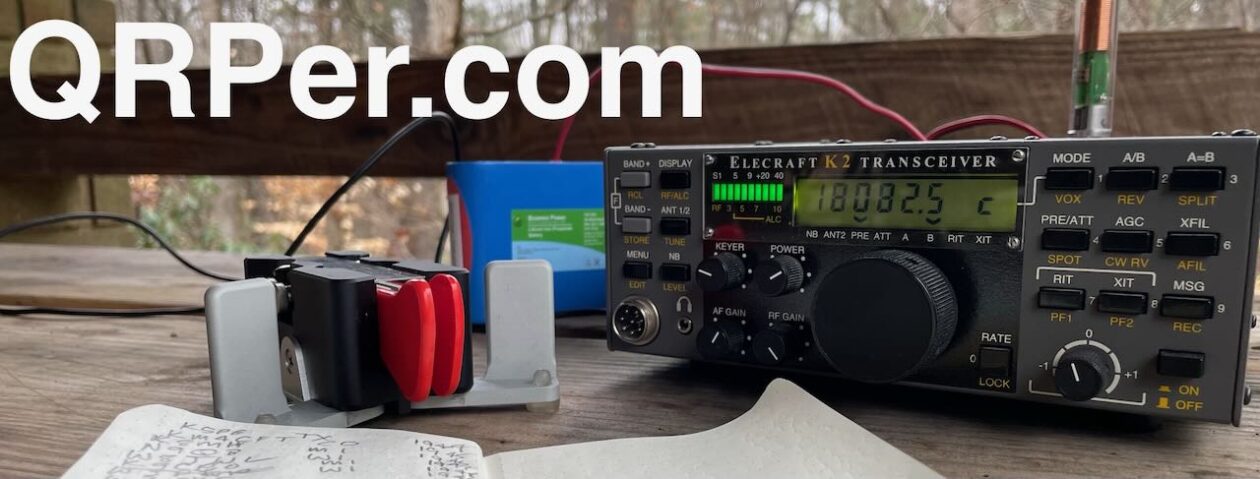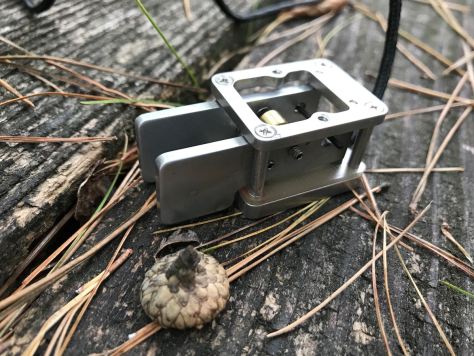I’ve gotten a few messages from readers lately asking, “Why no love for the Icom IC-705?”
Looking back, I realize that I haven’t had the ‘705 in the field for quite some time (at least, in a video and field report).
Truth is, the ‘705 has been doing duty as a shortwave listening receiver in shack and just hasn’t hopped into my field pack recently. Since it’s important for the health of all field radios to soak in the outdoors on a regular basis, I packed it in my bag and took it to one of my favorite parks.
Tuttle Educational State Forest (K-4861)
The weather was beautiful on Thursday, October 21, 2021.
When I arrived at Tuttle, the first thing I did was hike their 2 mile loop to get the blood pumping.

This also gave me time to decide on the antenna to deploy: my Chameleon CHA LEFS.

The CHA LEFS has served me quite well in the past, especially on days with mediocre propagation.
During my hike I decided to do the entire activation on 40 meters only, just to get a better idea how the CHA LEFS’ propagation footprint might look with a larger sample size.
Gear:
- Icom IC-705
- Icom IC-705 3D Printed Foot
- Chameleon CHA LEFS
- N0SA SOTA paddles
- Red Oxx C-Ruck
- Arborist throw line
- Rite In The Rain Weatherproof Cover/Pouch (affiliate link)
- Muji A6 Notepad (affiliate link)
On the Air

Setup was quite easy.
I deployed the CHA LEFS with the feed point at about 35-40′ into a large tree.
The radiator sloped down to a point in the middle of a field and the end was elevated perhaps 4′ off the ground. I secured the end of the antenna to a length of paracord, the end of which was attached to a heavy stick on the ground, stretching the radiator.
The CHA LEFS is resonant on 40 meters, so no external ATU was necessary.
I hopped on the air, started calling CQ POTA in CW and within 10 minutes was rewarded with 10 contacts. It doesn’t get much better than this for a good start!
I continued calling CQ and, in the end, worked a total of 22 contacts in 30 minutes–almost all in CW. Check out the video below to see how it all played out.
Many thanks to KC5F and N9UNX for the Park-To-Park contacts!
Video
Here’s my real-time, real-life video of the entire activation (less antenna set up and take-down):
Click here to view on YouTube.
QSO Map
The QSO Map shows an interesting pattern: a ring with a few close regional stations (almost NVIS), and an outer ring of 40 meter skywave:
Thank you!
I believe one of the attractions of activating parks and summits is the fact that we really have no idea in advance how it might all play out. It’s a bit like going fishing.
I’ve gotten a lot of questions from readers lately about what propagation tools I use. In truth, my main propagation forecasting tool is my buddy Mike (K8RAT). Before I head out–or if he knows I’m hitting the field–he’ll usually text me current conditions and they’re quite accurate.
At the end of the day, though, propagation forecasts never stop me from doing an activation when I want to play radio. I just go out there and see what happens. As I’m sure my childhood fishing buddy–my Great Uncle Luther–would have said, “Any day fishing is better than a good day at work!” (Of course, a real quote from Uncle Luther would have included more “colorful metaphors.”)
A special thanks to those of you who are supporting the site and channel through Patreon and the Coffee Fund. While certainly not a requirement as my content will always be free–I really appreciate the support.
73,
Thomas (K4SWL)








Great videos Thomas! Will the Icom IC-703+ make it to the field again?
73, Jim W9UUM
It does! Well…very briefly. It was showing signs of being affected by RF–keying was dodgy–I’m going to try again with an in-line choke.
Cheers,
Thomas
Tom, what is a good set of paddles to start out with doing POTA? Presently all I have is Bencher.
Thanks
Hi, Dennis,
There are many good ones out there. Some of my favorites (that are widely available) are those by CW Morse. They’re 3D printed, but of excellent quality. I’ve been very pleased. They’re also affordable. N0SA makes an amazing paddle, but only in *very* limited quantities when he has the spare time. There are many other great paddles out there, but they can get pricey.
I would encourage you to take your Bencher to the field too! Of course, you’ll have to be careful not to damage the paddles in transport.
Cheers,
Thomas
Thomas,
Here is pretty good paddle for not so much money. Lots of these manufactures want a lot for their keys and paddles.
this one has strong magnetic on bottom you could use to secure to a metal base or rig although so many rigs are AL, not steel.
I got one and like it for when need a small paddle.
https://www.aliexpress.com/item/1005003150083816.html?spm=a2g0s.9042311.0.0.27424c4dE5xGEj
73, ron, n9ee/r
Lol, that’s funny. That keyer is about 2days away from being delivered to me from China. I had to try it.
Mike, AD8EV
Lol, “isnt it cute?” Lol good one.
Mike AD8EV
I’ve had a 705 for some nine months now. during that time it has only been used as in the shack – until yesterday when it went into service as a pedestrian mobile rig. The background to this is that most of my operating in the field is SSB pedestrian mobile. My rig of choice for this type of operating is an eight year old Elecraft KX3. A couple of months ago the KX3 developed a fault which the UK importers don’t have the manpower to repair at the moment (Brexit problems). Seeking assistance from Elecraft in the USA I received a tremendous lot of help straight away and planned to send it to them for repair. However UK customs duties and Value Added Tax would have meant that route would have been very expensive. In the mean time I have been using my old Icom 703 and a Yaesu FT857 for this work. But they are heavy.
I have made a cradle for the 705 so it can be slung from the shoulder straps of my backpack and be operated as I am walking.
It works ok, but its form factor is not the best for /PM work. However it did OK during yesterday’s initial test. Think I will be using it, in the field, quite a bit in the next few weeks
Tom G0SBW
Ooops. got Brexit on the brain. The UK importers have Covid19 staffing problems – not Brexit problems
Good to see you do a POTA with the IC705. I have had a IC705 for about a year, now only QRP rig I use, great rig with lots of operational features. I’ve done like 5-7 park events with the rig. I always use an external battery.
One word of warning, do not be plugging in/out the spkr/mic to the IC705 with the power on. The manual states make sure rig is off. It also wants you to have power off when plugging in anything although some like the antenna dont really matter. The KEY could force the rig to xmt and if not ready might cause a problem. This could be true for any rig.
The reason the mic jack is 4 conductor has voltage on one of the rings (can be selected to be 3.3V or 8V in a menu). So if plugging in/out the mic and power is on it could short this voltage to ground.
My QRP rig of choice is the IC705, but dont think I would be doing setting on the ground events with it. The TX500 or to be sometimes the Xiegu X6100 would be more suited for this. I only do events with a table, either picnic or a small portable one I carry with a chair.
73, ron, n9ee/r
One question Steve,
Why do you feed the slopper/long wire at the top??? I think that is what you said. Most feed it at the bottom. If resonant length then radiation is in the middle, could see if using shorter wire.
73, ron, n9ee/r
The bands were not in good condition today. It was hit or miss. I got as far north as NH and only as far west as TX. Hopefully things will get better soon.
I have been going back and forth with several QRP rigs deciding how to upgrade my FT817. I am primarily a digital operator and the 705 seems to make sense to me. Anyway, I pulled the lever this week and it is on the way.
Also, I am sharing this one to our club groups.io. I gave a presentation on QRP a while back and a point of discussion was modes on 5-10 watts. You proved my point. Digital and CW are the most efficient modes for QRP. SSB is tough when your power is low and bands are not so good.
73, Steve VA3FLF/KM4FLF
Steve, your choice of the IC-705 is very solid especially since you plan to operate digital modes. It’s the most versatile field radio on the market for digi modes. You’re right in that you typically get more “bang per watt” with CW and digital modes.
Cheers,
Thomas